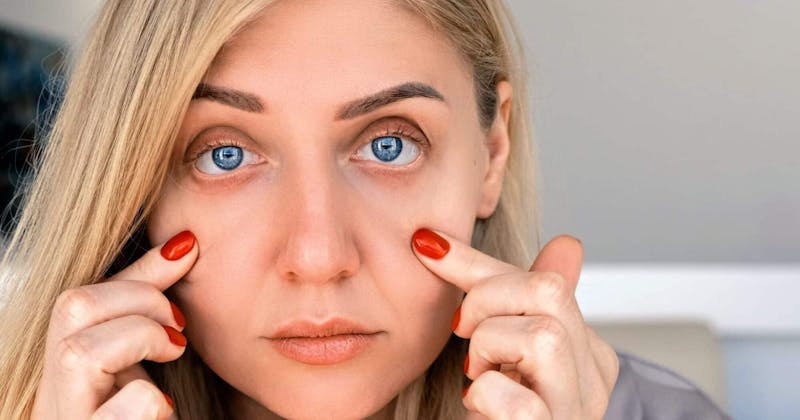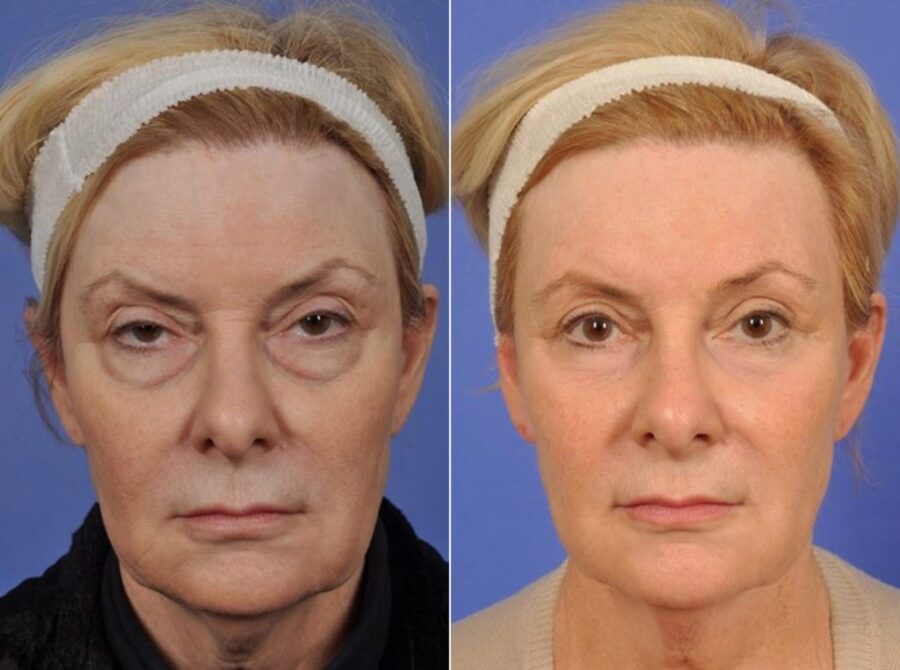
Are you tired of everyone commenting on how, well, tired you look all the time? Are you startled each time you look in the mirror first thing in the morning, shocked at how baggy or dark your under-eyes look? Perhaps you’ve tried a myriad of concealers, yet nothing seems to hide those dark circles.
Excessive under-eye bags and dark circles can have a drastic effect on your overall appearance. After all, the eyes are the window of the soul, right? No one wants to appear dull, exhausted, or aged, and this type of issue can take a significant toll on one’s self-esteem.
Know that you’re not alone. At W Cosmetic Surgery®®, we hear these complaints at least six times a day. Since studies have shown that the first place we look when we are assessing someone’s face is into their eyes, we understand and want to help explain why this happens. In this post, we’ll uncover some of the most common causes of dark circles and causes of under eye bags.
Most Common Causes of Dark Circles
Allergies
When you think of allergy symptoms, the first things that come to mind are most likely a runny, stuffy nose, but the same response occurs in the thin skin of the eyelids: swelling, dark circles under the eyes, and worsening of eyelid bags.
We’ve seen environmental allergies from molds, dyes, or medications cause eyelid swelling. But makeup (especially mascara) and eye drops, even those prescribed by your ophthalmologist, can cause these symptoms. In many cases, itching accompanies the swelling, and the skin can appear slightly shiny, darkened, or thickened.
Sinus Disease
Sinus disease is incredibly common in the area. About 2.7 million people in the United States have visited their physician’s office in the last few years for chronic sinusitis – whether it is from environmental allergies, pollutants, or preexisting anatomic problems.
Chronic sinusitis or sinus congestion can create pressure around the eyes, which can affect the blood vessels and skin in the eye area. This pressure can cause blood to pool in the vessels under the eyes, resulting in dark circles.
Sinusitis and allergies can also sometimes lead to fluid retention, which can manifest as puffiness under the eyes. When this puffiness combines with the natural shadows created by the eyes’ contours, it can give the appearance of dark circles.
Lack of Sleep
When you don’t get enough sleep, the blood vessels around your eyes can dilate (widen) and become more prominent. This dilation is thought to be a response to fatigue and stress. As the blood vessels expand, they can become more visible through the thin and delicate skin under the eyes, creating a bluish or dark appearance.
Treating Dark Circles
Some ways to treat dark circles under your eyes include:
- Treatment of Sinus Issues: Dark circles can sometimes be related to sinus congestion or allergies. Treating underlying sinus problems, such as allergies or sinusitis, can help reduce puffiness and discoloration under the eyes.
- Bleaching Agents (if related to pigment): If the dark circles are caused by excess melanin production or hyperpigmentation, bleaching agents containing ingredients like hydroquinone, kojic acid, or vitamin C can help lighten the skin and reduce the appearance of pigmentation.
- Better Sleep and Diet: Getting sufficient sleep, managing stress, and maintaining a balanced diet rich in vitamins and antioxidants can improve skin health and reduce the prominence of dark circles.Retinoids: Topical retinoids like retinol or prescription-strength retinoids (e.g., tretinoin) can stimulate collagen production and improve skin texture and tone. They may help reduce the appearance of fine lines and dark circles over time.
- Chemical Peels: Chemical peels can exfoliate the top layer of skin, promoting the growth of new, healthier skin cells. This can improve skin texture and reduce pigmentation, including dark circles. Peels with ingredients like glycolic acid or salicylic acid are commonly used.
- Laser Treatments: Laser treatments like the 3D Miracl™ microlaser peel—which uses the UltraClear™ cold fiber laser—are often considered effective for treating dark under-eye circles. These lasers can target pigment irregularities, stimulate collagen production, and improve skin tone. Consultation with an experienced skincare specialist is essential to determine the most suitable laser treatment for your specific case.
Most Common Causes of Under-Eye Bags
Thyroid Problems
The thyroid is a gland situated in the middle of your neck and adjacent to your throat. It regulates the body’s rate of metabolism. Thyroid output can be unduly low, giving rise to hypothyroidism, or in other words, an underactive thyroid. Symptoms of hypothyroidism include lack of energy, slow heartbeat, hair loss, fatigue, constipation, and skin changes. On the other hand, a thyroid can also be overactive, giving rise to hyperthyroidism. Symptoms of hyperthyroidism include a wide-eyed stare, rapid heartbeat, and swelling around the front of the shins. Sometimes a previous inflammation of the thyroid can cause changes, as well.
There is a link between abnormalities of the thyroid and the eye. For some reason, orbital and eyelid tissues swell and produce abnormal quantities of a sugar-like substance (mucopolysaccharide) that causes swelling of the orbit and worsens eyelid bags, creates edema of the skin, and occasionally discolors the skin.
Volume Loss
In many people who have lost a lot of weight, like those who practice extreme sports (such as Iron Man or ultra-marathons), or who are on certain medications, the loss of volume can make the eye area appear hollow. The bones of the face show—initially the cheekbone swelling looks good because it provides more definition to the face, but as it hollows more, the eyes look hollow and dark and give an overall unhealthy appearance to the face. Fatty deposits in the face are normal (think how full the faces of children are) and in general, heavier patients look younger!
Gravity
If it’s not the above, then gravity is probably the culprit. Lie down on your back and study your face with a hand mirror. If most of the issues that troubled you when you look in the mirror have disappeared, then gravity is the culprit.
Gravity pulls the eyelid fat pads out and down when you are upright. It pulls the cheeks down and makes the area between the under eyes and the cheeks appear empty. As we get older, the ligaments and connective tissues that hold our fat in place thin and lengthen, and the fat pads stretch downwards, creating multiple areas of alternating fullness and hollowness. When we lie flat, the ligaments are no longer put on and so the fat pads flow back into place. We look younger. Gravity is tough on us—but surgery can help. The best reason I know to consider intergalactic space travel in a weightless environment—our faces wouldn’t age!
Heredity
The quality and elasticity of your skin can depend on your genetic makeup. Some individuals may have genetically thinner or less elastic skin under the eyes, making it more prone to sagging and the formation of under-eye bags as they age.
Aging
As you age, your skin naturally loses elasticity due to a decrease in collagen and elastin production. Collagen is a protein that provides structural support to the skin, while elastin allows the skin to snap back into place. The loss of these components can lead to sagging and laxity of the skin under the eyes, making it more prone to forming bags.
With age, the muscles and connective tissues that support the eyelids and the fat pads around the eyes can weaken. When these structures become less firm, the fat can migrate forward, causing the appearance of puffiness and bags under the eyes.
Cigarette, Alcohol, and Salt Intake
If you regularly consume alcohol or salt, or if you’re a smoker, those may be the culprits of your under-eye bags.
Smoking damages collagen and elastin, which are essential for skin elasticity and firmness. This can lead to premature aging of the skin, causing it to sag and become more prone to under-eye bags.
Alcohol, on the other hand, is dehydrating and can lead to fluid retention in the body. This fluid retention can manifest as puffiness, particularly in the under-eye area.
Constantly adding more salt to your meals or grabbing a bag of salty chips? It’s probably affecting those bags under your eyes! High salt intake can cause the body to retain water, leading to overall fluid retention and puffiness, including in the under-eye area.
Stress
Excess and chronic stress is to blame for so many health issues. Chronic stress can lead to changes in hormonal balance, including increased levels of cortisol (the stress hormone). Elevated cortisol levels can weaken the skin’s structure and impair its ability to repair itself, potentially worsening the appearance of under-eye bags.
Stress can affect blood circulation, causing blood vessels to constrict and dilate irregularly. This can result in changes in skin color and the visibility of blood vessels under the eyes, contributing to the appearance of dark circles.
In addition, stress can lead to muscle tension, particularly in the face and eye area. Frequent squinting or furrowing of the brow due to stress can contribute to the development of fine lines and wrinkles, making under-eye bags more prominent.
Treating Under-Eye Bags
Some ways to treat under-eye bags include:
- Treating the Underlying Condition: If the dark circles are caused by an underlying medical condition like thyroid problems or kidney issues, it’s crucial to address these conditions first. Treating the root cause can help improve the appearance of dark circles.
- Morpheus8 (Radiofrequency Microneedling): Morpheus8 is a non-invasive skin treatment that combines radiofrequency (RF) energy with microneedling. It can be effective for improving skin texture, tightening loose skin, and reducing the appearance of fine lines and wrinkles. When used around the eyes, it can help with skin rejuvenation, which may indirectly improve the appearance of dark circles.
- Filler for Volume Loss: Dark circles can sometimes be the result of hollowing or volume loss under the eyes. Hyaluronic acid-based dermal fillers, such as Restylane or Juvederm, can be injected to restore volume to the under-eye area. This can help reduce the appearance of sunken eyes and shadows.
- Surgery – Blepharoplasty: Blepharoplasty is a surgical procedure designed to address bags under the eyes. It can be performed in a few ways:
-
- No-Scar Removal of Bags: In some cases, an incision can be made inside the lower eyelid (transconjunctival approach) to access and remove excess fat without leaving visible external scars. This approach is typically used when there is minimal excess skin.
- Fat Transfer or Liposculpture: Sometimes, fat may be transferred from another area of the body (fat grafting) or liposuction may be used to
-

Schedule a Consultation Today
Be sure to schedule a consultation with a trusted plastic surgeon who is especially experienced in eyelid surgery, as your eyes are some of the most delicate parts of the face. We hope this article was helpful and addressed some of your questions!

